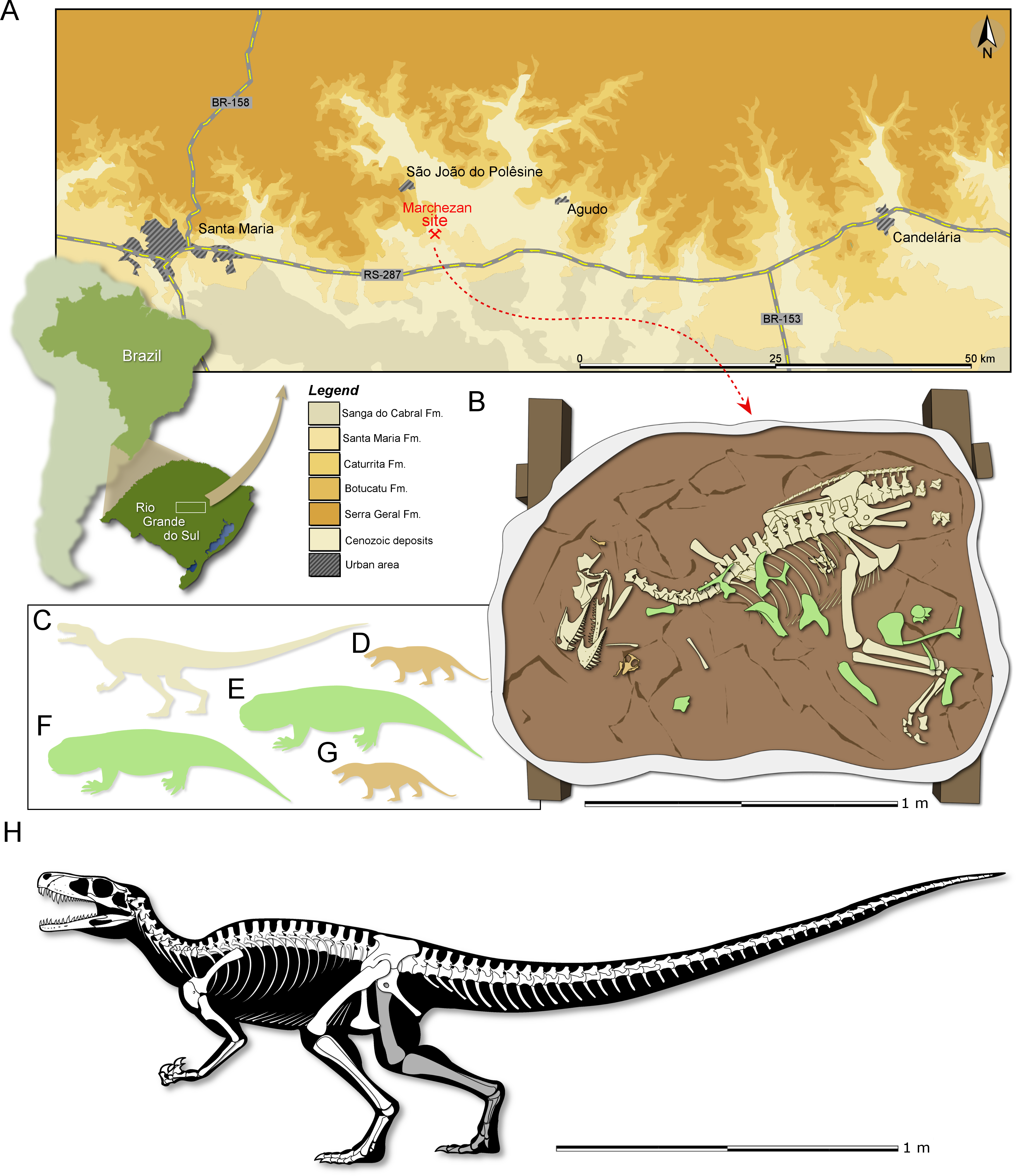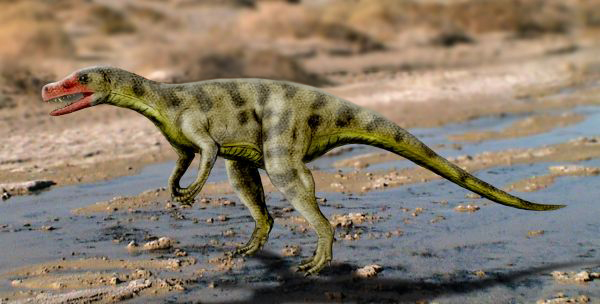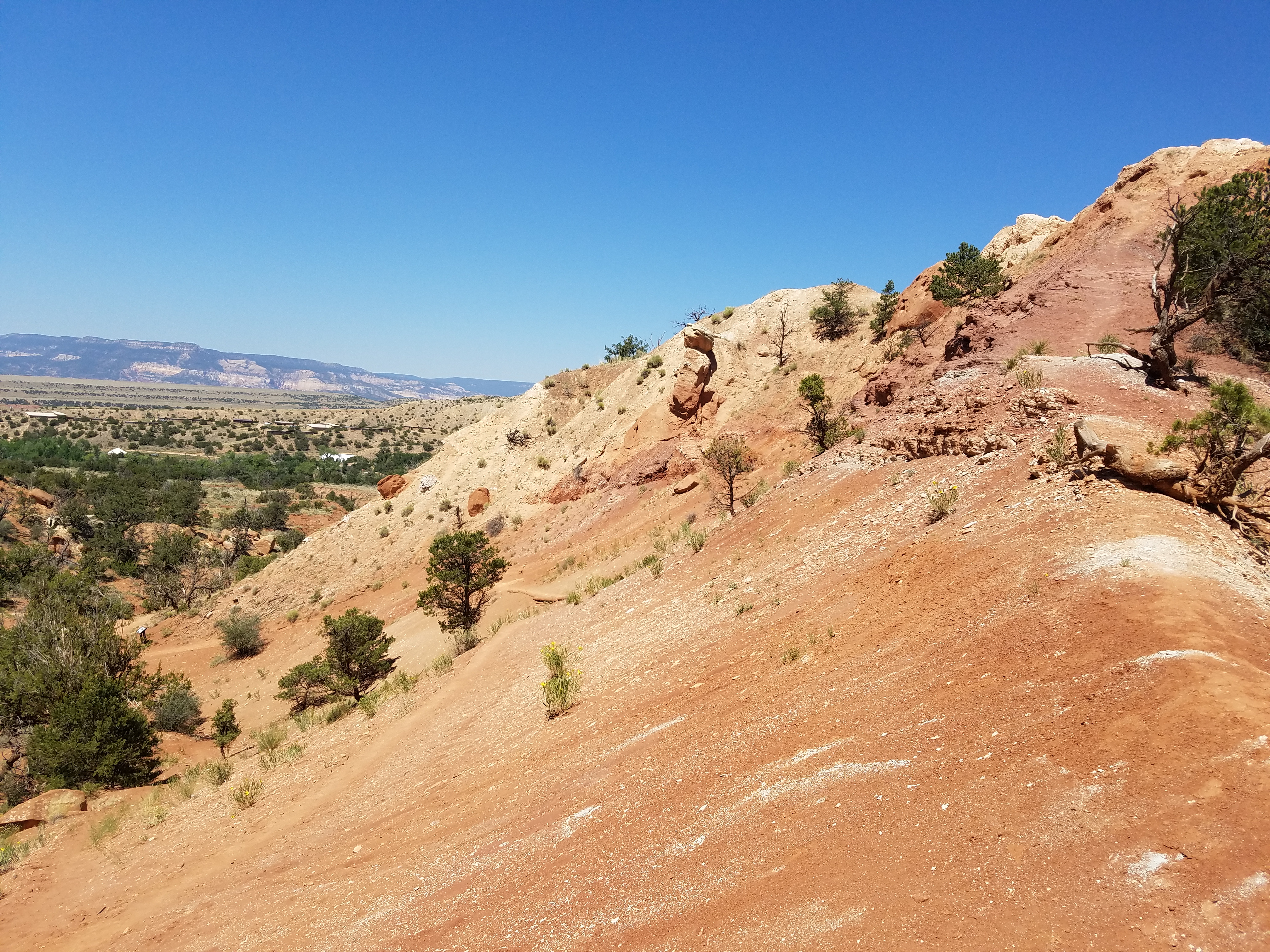|
Herrerasaurid
Herrerasauridae is a family of carnivorous dinosaurs, possibly basal to either theropods or even all of saurischians, or even their own branching from Dracohors, separate from Dinosauria altogether. They are among the oldest known dinosaurs, first appearing in the fossil record around 233.23 million years ago (the Carnian stage of the Late Triassic), before becoming extinct by the end of the Carnian stage. Herrerasaurids were relatively small-sized dinosaurs, normally no more than long, although the holotype specimen of "''Frenguellisaurus ischigualastensis"'' (nowadays considered a synonym of ''Herrerasaurus'' ''ischigualastensis'') is thought to have reached around 6 meters (20 ft) long. The best known representatives of this group are from South America (Brazil, Argentina), where they were first discovered in the 1930s in relation to ''Staurikosaurus'' and 1960s in relation to ''Herrerasaurus''. A nearly complete skeleton of ''Herrerasaurus ischigualastensis'' was discovered ... [...More Info...] [...Related Items...] OR: [Wikipedia] [Google] [Baidu] |
Gnathovorax
''Gnathovorax'' is a genus of herrerasaurid saurischian dinosaur from the Santa Maria Formation in Rio Grande do Sul, Brazil. The type and only species is ''Gnathovorax cabreirai'', described by Pacheco ''et al.'' in 2019. The type specimen comprises a mostly complete and well-preserved articulated skeleton (considered one of the best herrerasaurid skeletons ever discovered), which fossilized in close association with rhynchosaur and cynodont remains. The discovery of this superb specimen has shed light onto poorly understood aspects of herrerasaurid anatomy such as endocranial soft tissues. Discovery The holotype specimen, CAPPA/UFSM 0009, is an almost complete and partially articulated skeleton, lacking only portions of the left shoulder girdle and left forelimb. It was found in 2014 at the Marchezan site, in the municipality of São João do Polêsine, Rio Grande do Sul, Brazil. This locality preserved rocks from Santa Maria Formation in the Candelária Sequence of the Par ... [...More Info...] [...Related Items...] OR: [Wikipedia] [Google] [Baidu] |
Chindesaurus
''Chindesaurus'' ( ) is an extinct genus of basal saurischian dinosaur from the Late Triassic (213-210 million years ago) of the southwestern United States. It is known from a single species, ''C. bryansmalli'', based on a partial skeleton recovered from Petrified Forest National Park in Arizona. The original specimen was nicknamed "Gertie", and generated much publicity for the park upon its discovery in 1984 and airlift out of the park in 1985. Other fragmentary referred specimens have been found in Late Triassic sediments throughout Arizona, New Mexico, and Texas, but these may not belong to the genus. ''Chindesaurus'' was a bipedal carnivore, approximately as large as a wolf.Holtz, Thomas R. Jr. (2012) ''Dinosaurs: The Most Complete, Up-to-Date Encyclopedia for Dinosaur Lovers of All Ages,'Winter 2011 Appendix. ''Chindesaurus''s classification is debated, and various papers have had different conclusions on its affinities. Its fossils were originally believed to belong to "pro ... [...More Info...] [...Related Items...] OR: [Wikipedia] [Google] [Baidu] |
Sanjuansaurus
''Sanjuansaurus'' (" San Juan Province lizard") is a genus of herrerasaurid dinosaur from the Late Triassic (Carnian) Ischigualasto Formation of the Ischigualasto-Villa Unión Basin in northwestern Argentina. Discovery ''Sanjuansaurus'' was named and described in 2010 by Oscar Alcober and Ricardo Martinez. The type species was named ''S. gordilloi'' after Raul Gordillo, the head fossil preparator and artist of the San Juan Museum. It is known from and based on an associated and partially articulated partial skeleton ( PVSJ 605) consisting of a jaw fragment, most of the vertebral column from the axis to the anterior tail, the shoulder blades, an ulna, part of the pelvis, most of the long bones of the legs, and a few other bones. PVSJ 605 was discovered in 1994, in gray-green sandstone 40 meters above the base of the Ischigualasto Formation, in Ischigualasto Provincial Park in San Juan, Argentina. An ash bed from the early part of the formation dates to approximately 231 ... [...More Info...] [...Related Items...] OR: [Wikipedia] [Google] [Baidu] |
Staurikosaurus
''Staurikosaurus'' (Pronounced /ˌstɔɹ̠ikoʊˈsɔɹ̠ʌs/, '' STOR-ree-koh-SOR-ruhs''; "Southern Cross lizard") is a genus of herrerasaurid dinosaur from the Late Triassic of Brazil, found in the Santa Maria Formation. Description Colbert (1970) described ''Staurikosaurus'' as a small and agile, bipedal predator.Colbert, E. H. (1970). A Saurischian dinosaur from the Triassic of Brazil. AM. MUS. NOVITATES 2405; 1-39 ''Staurikosaurus'' lived during the late-Carnian and early-Norian stage, of the Late Triassic, approximately 225 million years ago—which makes it one of the earliest dinosaurs known. Its length is measured at long,Grillo, O.N. and Azevedo, S.A.K. (2011). "Recovering missing data: estimating position and size of caudal vertebrae in ''Staurikosaurus pricei'' Colbert, 1970." ''Annals of the Brazilian Academy of Sciences'', but Gregory S. Paul presented a lower length estimate of and a body mass estimate of . ''Staurikosaurus'' was small in comparison to later t ... [...More Info...] [...Related Items...] OR: [Wikipedia] [Google] [Baidu] |
Herrerasaurus
''Herrerasaurus'' is likely a genus of saurischian dinosaur from the Late Triassic period. Measuring long and weighing around , this genus was one of the earliest dinosaurs from the fossil record. Its name means "Herrera's lizard", after the rancher who discovered the first specimen in 1958 in South America. All known fossils of this carnivore have been discovered in the Ischigualasto Formation of Carnian age (late Triassic according to the ICS, dated to 231.4 million years ago) in northwestern Argentina. The type species, ''Herrerasaurus ischigualastensis'', was described by Osvaldo Reig in 1963 and is the only species assigned to the genus. ''Ischisaurus'' and ''Frenguellisaurus'' are synonyms. For many years, the classification of ''Herrerasaurus'' was unclear because it was known from very fragmentary remains. It was hypothesized to be a basal theropod, a basal sauropodomorph, a basal saurischian, or not a dinosaur at all but another type of archosaur. However, with t ... [...More Info...] [...Related Items...] OR: [Wikipedia] [Google] [Baidu] |
Dinosaur
Dinosaurs are a diverse group of reptiles of the clade Dinosauria. They first appeared during the Triassic Geological period, period, between 243 and 233.23 million years ago (mya), although the exact origin and timing of the #Evolutionary history, evolution of dinosaurs is a subject of active research. They became the dominant terrestrial vertebrates after the Triassic–Jurassic extinction event 201.3 mya and their dominance continued throughout the Jurassic and Cretaceous periods. The fossil record shows that birds are feathered dinosaurs, Evolution of birds, having evolved from earlier Theropoda, theropods during the Late Jurassic epoch, and are the only dinosaur lineage known to have survived the Cretaceous–Paleogene extinction event approximately 66 mya. Dinosaurs can therefore be divided into avian dinosaurs—birds—and the extinct non-avian dinosaurs, which are all dinosaurs other than birds. Dinosaurs are varied from taxonomy (biology), taxonomic, ... [...More Info...] [...Related Items...] OR: [Wikipedia] [Google] [Baidu] |
Daemonosaurus
''Daemonosaurus'' is an extinct genus of possible theropod dinosaur from the Late Triassic of New Mexico. The only known fossil is a skull and neck fragments from deposits of the latest Triassic Chinle Formation at Ghost Ranch. ''Daemonosaurus'' was an unusual dinosaur with a short skull and large, fang-like teeth. It lived alongside early Neotheropoda, neotheropods such as ''Coelophysis'', which would have been among the most common dinosaurs by the end of the Triassic. However, ''Daemonosaurus'' retains several Plesiomorphy and symplesiomorphy, plesiomorphic ("primitive") traits of the snout, and it likely lies outside the clade Neotheropoda. It may be considered a late-surviving basal (phylogenetics), basal theropod or non-theropod basal Saurischia, saurischian, possibly allied to other early predatory dinosaurs such as Herrerasauridae, herrerasaurids or ''Tawa hallae, Tawa''. Discovery ''Daemonosaurus'' is known from a single fossil, the holotype CM 76821, which consists of ... [...More Info...] [...Related Items...] OR: [Wikipedia] [Google] [Baidu] |
Tawa Hallae
''Tawa'' (named after the Hopi word for the Puebloan sun god) is a genus of possible basal theropod dinosaurs from the Late Triassic period. The fossil remains of ''Tawa hallae'', the type and only species were found in the Hayden Quarry of Ghost Ranch, New Mexico, US. Its discovery alongside the relatives of ''Coelophysis ''and ''Herrerasaurus'' supports the hypothesis that the earliest dinosaurs arose in Gondwana during the early Late Triassic period in what is now South America, and radiated from there around the globe. The specific name honours Ruth Hall, founder of the Ghost Ranch Museum of Paleontology. Description ''Tawa'' was estimated to have been long as an adult, with a weight of . ''Tawa'' preserves characters that can be associated with different dinosaur taxa. Its skull morphology resembles that of coelophysoids and the ilium approximates that of a herrerasaurid. Like the coelophysoids, ''Tawa'' has a kink in its upper jaws, between the maxilla and the premax ... [...More Info...] [...Related Items...] OR: [Wikipedia] [Google] [Baidu] |
Dracohors
Dinosauromorpha is a clade of avemetatarsalians (archosaurs closer to birds than to crocodilians) that includes the Dinosauria (dinosaurs) and some of their close relatives. It was originally defined to include dinosauriforms and lagerpetids, with later formulations specifically excluding pterosaurs from the group. Birds are the only dinosauromorphs which survive to the present day. Classification The name "Dinosauromorpha" was briefly coined by Michael J. Benton in 1985. It was considered an alternative name for the group "Ornithosuchia", which was named by Jacques Gauthier to correspond to archosaurs closer to dinosaurs than to crocodilians. Although "Ornithosuchia" was later recognized as a misnomer (since ornithosuchids are now considered closer to crocodilians than to dinosaurs), it was still a more popular term than Dinosauromorpha in the 1980s. The group encompassed by Gauthier's "Ornithosuchia" and Benton's "Dinosauromorpha" is now given the name Avemetatarsalia. ... [...More Info...] [...Related Items...] OR: [Wikipedia] [Google] [Baidu] |
Saurischia
Saurischia ( , meaning "reptile-hipped" from the Greek ' () meaning 'lizard' and ' () meaning 'hip joint') is one of the two basic divisions of dinosaurs (the other being Ornithischia), classified by their hip structure. Saurischia and Ornithischia were originally called orders by Harry Seeley in 1888, though today most paleontologists classify Saurischia as an unranked clade rather than an order.Weishampel, D.B., Dodson, P., and Osmólska, H. (eds.). (2004). ''The Dinosauria. 2nd edition''. University of California Press, Berkeley. 833 pp. Description All carnivorous dinosaurs (certain types of theropods) are traditionally classified as saurischians, as are all of the birds and one of the two primary lineages of herbivorous dinosaurs, the sauropodomorphs. At the end of the Cretaceous Period, all saurischians except birds became extinct in the course of the Cretaceous–Paleogene extinction event. Birds, as a group of maniraptoran theropod dinosaurs, are a sub-clade of s ... [...More Info...] [...Related Items...] OR: [Wikipedia] [Google] [Baidu] |
Theropods
Theropoda (; from ancient Greek , (''therion'') "wild beast"; , (''pous, podos'') "foot"">wiktionary:ποδός"> (''pous, podos'') "foot" is one of the three major groups (clades) of dinosaurs, alongside Ornithischia and Sauropodomorpha. Theropods, both extant and extinct, are characterized by hollow bones and three toes and claws on each limb. They are generally classed as a group of saurischian dinosaurs, placing them closer to sauropodomorphs than to ornithischians. They were ancestrally carnivorous, although a number of theropod groups evolved to become herbivores and omnivores. Members of the subgroup Coelurosauria and possibly some other or all theropods were covered in feathers. In the Jurassic, birds evolved from small specialized coelurosaurian theropods, and are currently represented by about 11,000 living species, making theropods the only group of dinosaurs alive today. Theropods first appeared during the Carnian age of the late Triassic period ... [...More Info...] [...Related Items...] OR: [Wikipedia] [Google] [Baidu] |
Theropoda
Theropoda (; from ancient Greek [wiktionary:θηρίον, , (''therion'') "wild beast"; wiktionary:πούς, , wiktionary:ποδός, (''pous, podos'') "foot"]) is one of the three major groups (Clade, clades) of Dinosaur, dinosaurs, alongside Ornithischia and Sauropodomorpha. Theropods, both extant and extinct, are characterized by hollow bones and three toes and claws on each limb. They are generally classed as a group of saurischian dinosaurs, placing them closer to sauropodomorphs than to ornithischians. They were ancestrally carnivorous, although a number of theropod groups evolved to become herbivores and omnivores. Members of the subgroup Coelurosauria and possibly some other or all theropods were covered in Feather, feathers. In the Jurassic, birds evolved from small specialized coelurosaurian theropods, and are currently represented by about 11,000 living species, making theropods the only group of dinosaurs alive today. Theropods first appeared during the Ca ... [...More Info...] [...Related Items...] OR: [Wikipedia] [Google] [Baidu] |










